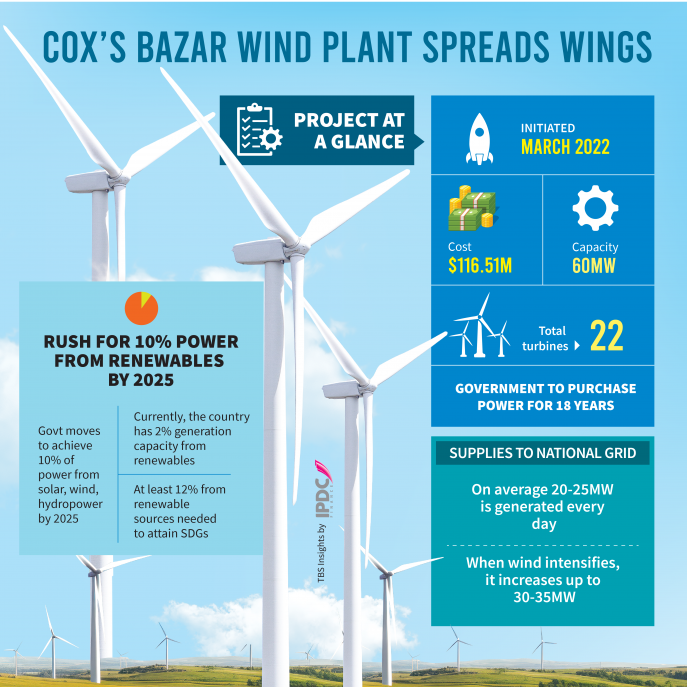
Bangladesh’s China-funded first commercial wind power plant starts production
Bangladesh has achieved a new milestone in its renewable energy ambition, with the country’s first commercial wind power plant going into full production this month.
The 724 km long coastal region of Bangladesh has significant wind power generation potential. The country produces over 890MW from renewable sources – but only a meager 2.9 MW of this previously came from wind energy, and the rest from solar parks and the country’s lone hydropower plant at Kaptai in Rangamati, according to Sustainable And Renewable Energy Development Authority.
Initiated in March 2022 with a total cost of $US 116.51 million, US-DK Green Energy (BD) Ltd is implementing the project, funded by Wuling Power Corporation Limited – a subsidiary of the Chinese State Power Investment Corporation Limited (SPIC). The Chinese firm Envision Energy Ltd, a manufacturer of smart wind turbines, supplied the turbines.
The plant, a large-scale centralised wind power plant, facilitated the South Asian country’s energy transition and green development. Bangladesh joined the global wind power club with the inauguration of its Cox’s Bazar wind power project.
The wind power plant in Cox’s Bazar, boasting a capacity of 60 megawatts, started full-scale operation on 8 March 2024 and has been running smoothly ever since, according to Bangladesh officials.
“The electricity generated by the new power plant is being directly supplied to the national grid. Experiments were conducted to ensure a smooth connection before the commercial launch,” the official said.
Installation of 20 out of 22 turbines of the plant has already been completed and the remaining work is expected to be completed this month.
“The construction of the wind power plant project has been completed, and it is now in commercial production. The capacity test was held on 7 March, 2024 and 60 MW of electricity is connected to the national grid,” Project Director Engineer Mukit Alam Khan, a representative of the Chinese company implementing the project said.
He also said they have an agreement with the government to supply 60 megawatts (MW) of electricity from the power plant.
“Currently, 20 turbines, each with a capacity of 3 MW, are operational, providing a total of 60 MW of electricity. The installation of the remaining two turbines is underway.” he said.
The firm overseeing the project has an 18-year contract with the government over the sale of electricity.
Situated near the seacoast, the project reached a trial milestone on 26 May 2023, injecting 30 MW of electricity into the national grid.
Upon its full operation, the project will provide Bangladesh with about 145 million kWh of clean electricity per year, reduce coal consumption by 44,600 tons and carbon dioxide emissions by 109,200 tons, as well as meet the electricity demand of 100,000 households, according to project officials.
Yin Bobo, director of Cox’s Bazar Wind Power Plant, told the Chinese news outlet Xinhua that the project has customised the “China Plan” for Bangladesh, devising site-specific solutions for the coastal areas characterised by frequent tropical cyclone disasters, poor alluvial plain geological foundations, and low average wind speed.
Notably, the initiative has created over 1,500 jobs during construction, with ongoing training for the eight operations and maintenance staff. Additionally, 25 officials are deployed to operate the plant.
Yin emphasised that Wuling Power Corporation will continue to focus on the development of green energy and assist Bangladesh in its low-carbon energy transformation, aiming to realise the dream of “Golden Bangladesh” at an early date.
Besides its immediate impact on electricity generation, the wind power project in Cox’s Bazar marks a significant stride in Bangladesh’s commitment to environmental sustainability. The project is poised to mitigate the effects of climate change, enhance air quality, and reduce the nation’s reliance on fossil fuels.

Wind energy in Bangladesh
This isn’t the country’s first wind power project. The Bangladesh Power Development Board constructed a 0.9MW wind-based power plant near the dam along the River Muhuri in Feni in 2005.
Three years later, a 1MW wind power plant was set up in Kutubdia, Cox’s Bazar. Both plants are now out of operation due to a lack of supervision and interest from the Board.
Rush for generating 10% from renewables by 2025
Currently, three more wind projects with a cumulative power generation capacity of 102MW are underway in Sirajganj, Bagerhat, and Chuadanga. Besides, contractor selection for a 50MW wind power project in Chandpur and a 30MW plant in Feni is in the pipeline.
In September 2022, the Bangladesh Power Development Board signed a contract with Mongla Green Power Limited to build a 55MW wind power plant in Mongla, Bagerhat. Mongla Green Power Ltd is a consortium of Envision Energy (Jiangsu) Co Ltd, China, SQ Trading and Engineering, Bangladesh, and Envision Renewable Energy Bangladesh Ltd, Hong Kong, China.
The government is moving for the new plants given its determination to achieve its target of generating 10% of electricity from renewables, including solar, hydropower, and wind, by 2025.
Currently, the country has the capacity to generate 2% of its electricity from renewable sources, according to the Bangladesh Power Development Board. At least 12% of electricity is needed from renewable sources to attain the Sustainable Development Goals or SDGs.
Earlier, the government had set targets of producing at least 5% of the total electricity from renewable sources by 2015 and 10% by 2020, but none of them could be achieved yet, according to the Ministry of Power, Energy, and Mineral Resources.
Sources:
- Dhaka Tribune, March 19, 2024. https://www.dhakatribune.com/bangladesh/291084/cox’s-bazar-to-generate-60mw-from-wind-energy-by
- The Business Standard, March 19, 2024. https://www.tbsnews.net/bangladesh/energy/turning-wind-wonder-20mw-being-supplied-national-grid-countrys-lone-wind-power
- The Daily Star, March 19, 2024. https://www.thedailystar.net/environment/natural-resources/energy/news/55mw-wind-power-plant-be-set-mongla-3110991